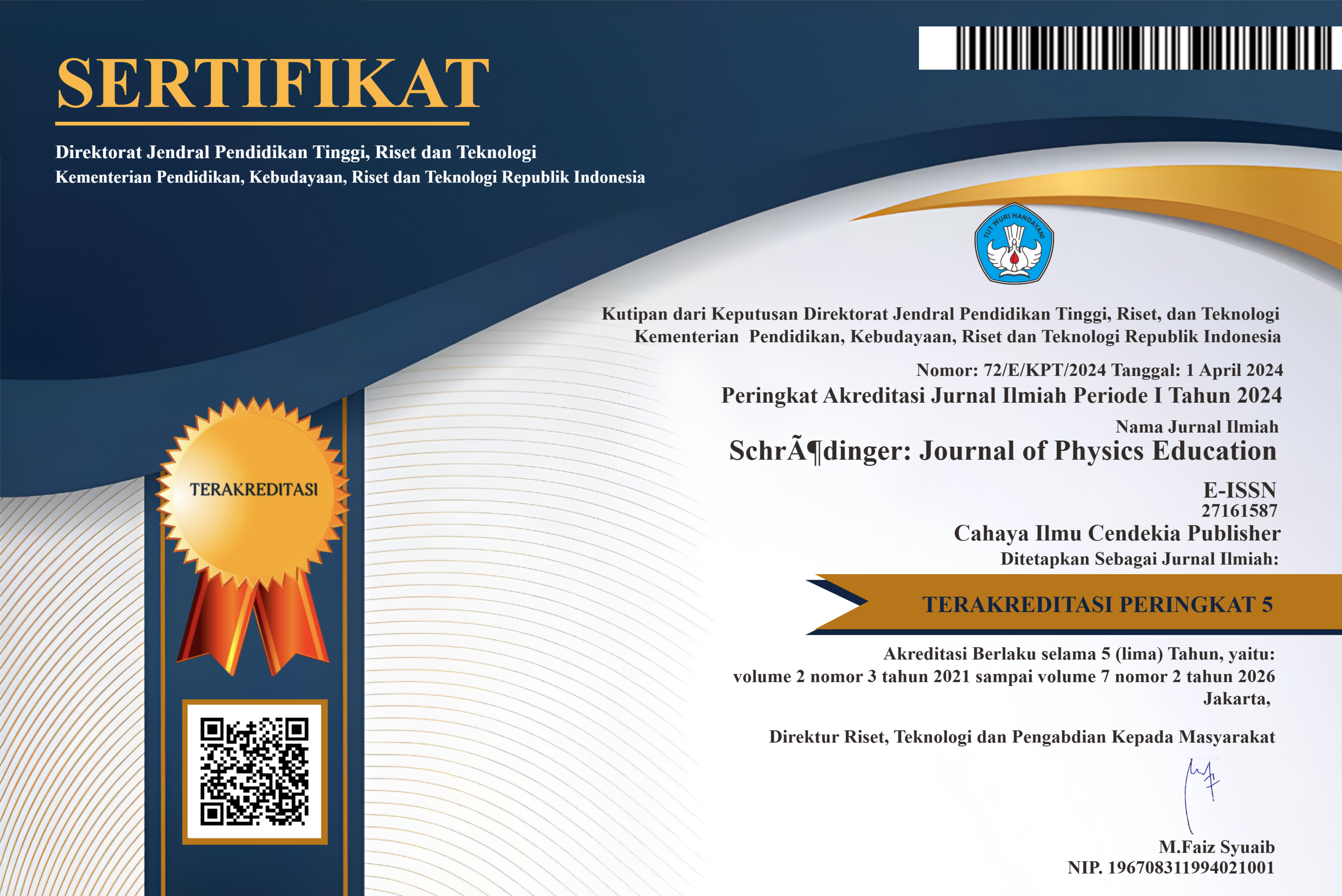Development of Three Tier Online Test Diagnostic of Misconception for Topic Free Fall Motion
Abstract
Purpose of the study: This study aimed to develop an online Three Tier Test Diagnostic of misconception in topic free fall motion.
Methodology: This research is development research using a development model 4D by Thiagarajan (Define, Desain, Development, and Dissemination). However, the research is only limited to the Development stage because the research objectives have been achieved. The data collection instrument is a media expert validation questionnaire. The research data includes quantitative data in the form of expert validator evaluations and qualitative data in the form of comments and suggestions given by expert validators.
Main Findings: The results showed that the product three tier online test diagnostic was feasible to use based on expert validation with a very feasible category. The resulting product has five item questions and consist of three tiers. The first tier is multiple choice questions, second is reason for answering question, and third tier is curiosity response index (CRI).
Novelty/Originality of this study: The novelty of this research is uses an online test. This is expected to be able to support the effectiveness of further research by researchers.
References
M. Maison et al., “Comparison of student attitudes towards natural sciences,” Int. J. Eval. Res. Educ., vol. 9, no. 1, pp. 54–61, 2020, doi: 10.11591/ijere.v9i1.20394.
R. Fitriani, Maison, Asrial, S. Purwaningsih, and R. Asma, “Diagnosing Students’ Conception of Wave Propagation Using the Five-Tier Isomorphic Instrument,” J. Penelit. Pendidik. IPA, vol. 9, no. 11, pp. 9461–9473, 2023, doi: 10.29303/jppipa.v9i11.5413.
Muthia Hanifah, “Meta Analisis Miskonsepsi Buku Teks Biologi SMA Kelas XI,” J. Biol. dan Pembelajarannya, vol. 8, no. 1, pp. 32–39, 2021, doi: 10.29407/jbp.v8i1.15735.
N. Suprapto, “Do We Experience Misconceptions?: An Ontological Review of Misconceptions in Science,” Stud. Philos. Sci. Educ., vol. 1, no. 2, pp. 50–55, 2020, doi: 10.46627/sipose.v1i2.24.
U. Hasanah, “The Effectiveness of STEM Education for Overcoming Students’ Misconceptions in High School Physics: Engineering Viewpoint,” Sci. Educ. Int., vol. 31, no. 1, pp. 5–13, 2020, doi: 10.33828/sei.v31.i1.1.
J. Gouvea, “Processing misconceptions: dynamic systems perspectives on thinking and learning,” Front. Educ., vol. 8, no. August, pp. 1–12, 2023, doi: 10.3389/feduc.2023.1215361.
S. B. Pickett, C. Nielson, H. Marshall, K. D. Tanner, and J. D. Coley, “Effects of Reading Interventions on Student Understanding of and Misconceptions about Antibiotic Resistance,” J. Microbiol. Biol. Educ., vol. 23, no. 1, 2022, doi: 10.1128/jmbe.00220-21.
H. J. Duda, D. C. Wibowo, F. R. E. Wahyuni, A. E. Setyawan, and M. R. Subekti, “Examines the misconceptions of students biology education: Health biotechnology,” Pedagogika, vol. 142, no. 2, pp. 182–199, 2021, doi: 10.15823/p.2021.142.10.
C. L. Thomas and L. A. J. Kirby, “Situational interest helps correct misconceptions: An investigation of conceptual change in university students,” Instr. Sci., vol. 48, no. 3, pp. 223–241, 2020, doi: 10.1007/s11251-020-09509-2.
C. Chen, G. Sonnert, P. M. Sadler, D. Sasselov, and C. Fredericks, “The impact of student misconceptions on student persistence in a MOOC,” J. Res. Sci. Teach., vol. 57, no. 6, pp. 879–910, 2020, doi: 10.1002/tea.21616.
C. Chen, G. Sonnert, P. M. Sadler, and S. Sunbury, “The impact of high school life science teachers’ subject matter knowledge and knowledge of student misconceptions on students’ learning,” CBE Life Sci. Educ., vol. 19, no. 1, 2020, doi: 10.1187/cbe.19-08-0164.
A. Volfson, H. Eshach, and Y. Ben-Abu, “Identifying physics misconceptions at the circus: The case of circular motion,” Phys. Rev. Phys. Educ. Res., vol. 16, no. 1, p. 10134, 2020, doi: 10.1103/PHYSREVPHYSEDUCRES.16.010134.
I. Zhang, K. B. Givvin, J. M. Sipple, J. Y. Son, and J. W. Stigler, “Instructed Hand Movements Affect Students’ Learning of an Abstract Concept From Video,” Cogn. Sci., vol. 45, no. 2, 2021, doi: 10.1111/cogs.12940.
J. Bill, S. J. Gershman, and J. Drugowitsch, “Visual motion perception as online hierarchical inference,” Nat. Commun., vol. 13, no. 1, pp. 1–17, 2022, doi: 10.1038/s41467-022-34805-5.
E. Stach et al., “Autonomous experimentation systems for materials development: A community perspective,” Matter, vol. 4, no. 9, pp. 2702–2726, 2021, doi: 10.1016/j.matt.2021.06.036.
P. H. Winingsih et al., “Analysis of understanding of physics concepts through problem solving units review in free fall motion materials,” Rev. Mex. Fis. E, vol. 20, no. 2, pp. 1–6, 2023, doi: 10.31349/RevMexFisE.20.020205.
S. Siswanto, H. Hartono, B. Subali, P. Marwoto, and R. S. Iswari, “Which Arrived First ? A Simple Experiment Using Smartphone to Analyze Parabolic and Free Fall Motion Simultaneously,” Int. Conf. Sci. Educ. Technol., vol. 7, pp. 533–538, 2021.
D. M. Kurniawati and F. U. Ermawati, “Analysis Students’ Conception Using Four-Tier Diagnostic Test for Dynamic Fluid Concepts,” J. Phys. Conf. Ser., vol. 1491, no. 1, pp. 0–7, 2020, doi: 10.1088/1742-6596/1491/1/012012.
Y. Rahmawati, Zulhipri, O. Hartanto, I. Falani, and D. Iriyadi, “Students’ Conceptual Understanding in Chemistry Learning Using Phet Interactive Simulations,” J. Technol. Sci. Educ., vol. 12, no. 2, pp. 303–326, 2022, doi: 10.3926/jotse.1597.
A. Y. Adhim, B. Jatmiko, and T. Prastowo, “Physics Teacher’s Misconceptions About Direct Current Material,” IJORER Int. J. Recent Educ. Res., vol. 2, no. 6, pp. 664–670, 2021, doi: 10.46245/ijorer.v2i6.160.
C. Rizki and W. Setyarsih, “Identifikasi Miskonsepsi Siswa dan Penyebabnya pada Materi Elastisitas Menggunakan Three–Tier Diagnostic Tes,” Inov. Pendidik. Fis., vol. 11, no. 3, pp. 32–43, 2022.
B. Reid O’Connor and S. Norton, “Exploring the challenges of learning quadratic equations and reflecting upon curriculum structure and implementation,” Math. Educ. Res. J., vol. 36, no. 1, pp. 151–176, 2024, doi: 10.1007/s13394-022-00434-w.
F. N. Salsabila and F. U. Ermawati, “Validity and Reliability of Conception Diagnostic Test Using Five-Tier Format for Elasticity Concepts,” IPF Inov. Pendidik. Fis., vol. 9, no. 3, pp. 439–446, 2020, doi: 10.26740/ipf.v9n3.p439-446.
F. Alatas, S. Ilhamiah, and A. Suryadi, “Identification of Students’ Misconceptions Using Isomorphic Test: the Case of Newton’S Law of Motion,” Edusains, vol. 13, no. 2, pp. 174–184, 2021, doi: 10.15408/es.v13i2.23967.
Z. D. Kirbulut and O. Geban, “Using three-tier diagnostic test to assess students’ misconceptions of states of matter,” Eurasia J. Math. Sci. Technol. Educ., vol. 10, no. 5, pp. 509–521, 2014, doi: 10.12973/eurasia.2014.1128a.
S. M. Inggit, W. Liliawati, and I. Suryana, “Identifikasi Miskonsepsi dan Penyebabnya Menggunakan Instrumen Five-Tier Fluid Static Test (5TFST) pada Peserta Didik Kelas XI Sekolah Menengah Atas,” J. Teach. Learn. Phys., vol. 6, no. 1, pp. 49–68, 2021, doi: 10.15575/jotalp.v6i1.11016.
T. Neidorf, A. Arora, E. Erberber, Y. Tsokodayi, and T. Mai, Student Misconceptions and Errors in Physics and Mathematics, vol. 9. 2019.
A. Andariana, S. Zubaidah, S. Mahanal, and E. Suarsini, “Identification of biology students’ misconceptions in human anatomy and physiology course through three-tier diagnostic test,” J. Educ. Gift. Young Sci., vol. 8, no. 3, pp. 1071–1085, 2020, doi: 10.17478/JEGYS.752438.
H. E. Haryono and K. N. Aini, “Diagnosis misconceptions of junior high school in Lamongan on the heat concept using the three-tier test,” J. Phys. Conf. Ser., vol. 1806, no. 1, 2021, doi: 10.1088/1742-6596/1806/1/012002.
D. F. Saputri and L. Angraeni, “Pengembangan Tes Diagnostik Three Tier Test pada Materi Pesawat Sederhana untuk Peserta Didik Kelas VIII SMP,” J. Pendidik. Sains dan Apl., vol. 04, no. 02, pp. 54–60, 2021.
C. F. Rumapea and R. Silaban, “Pengembangan Instrumen Tes Diagnostik Three-Tier Multiple Choice Berbasis Android Based Test Untuk Mengukur Miskonsepsi Siswa Pada Materi Laju Reaksi Kelas XI SMA,” Cendekia J. Ilm. Pendidik., vol. 10, no. 2, pp. 313–321, 2022.
S. Türkoguz, “Investigation of Three-Tier Diagnostic and Multiple Choice Tests on Chemistry Concepts with Response Change Behaviour,” Int. Educ. Stud., vol. 13, no. 9, p. 10, 2020, doi: 10.5539/ies.v13n9p10.
J. Stanja, W. Gritz, J. Krugel, A. Hoppe, and S. Dannemann, “Formative assessment strategies for students’ conceptions—The potential of learning analytics,” Br. J. Educ. Technol., vol. 54, no. 1, pp. 58–75, 2023, doi: 10.1111/bjet.13288.
A. Halim, E. Mahzum, M. Yacob, I. Irwandi, and L. Halim, “The impact of narrative feedback, e-learning modules and realistic video and the reduction of misconception,” Educ. Sci., vol. 11, no. 4, 2021, doi: 10.3390/educsci11040158.
K. Choudhary et al., “Recent advances and applications of deep learning methods in materials science,” npj Comput. Mater., vol. 8, no. 1, 2022, doi: 10.1038/s41524-022-00734-6.
R. Puspitasari, F. Mufit, and Asrizal, “Conditions of learning physics and students ’ understanding of the concept of motion during the covid-19 pandemic Conditions of learning physics and students ’ understanding of the concept of motion during the covid-19 pandemic,” J. Phys. Conf. Ser., 2021, doi: 10.1088/1742-6596/1876/1/012045.
A. Angelia, S. Q. Muminov, and D. T. Obafemi, “Development of Physics Modules with Science, Environment, Technology, and Society (SETS) Approaches to Motion and Force Material,” Schrödinger J. Phys. Educ., vol. 4, no. 3, pp. 78–85, 2023, doi: 10.37251/sjpe.v4i3.694.
K. A. Mudanta, I. G. Astawan, and I. N. L. Jayanta, “Instrumen Penilaian Motivasi Belajar dan Hasil Belajar IPA Siswa Kelas V Sekolah Dasar,” Mimb. Ilmu, vol. 25, no. 2, p. 101, 2020, doi: 10.23887/mi.v25i2.26611.
D. C. Kartiko and M. Habibbulloh, “Revealing physical education students’ misconception in sport biomechanics,” J. Phys. Conf. Ser., vol. 1006, no. 1, pp. 218–222, 2018, doi: 10.1088/1742-6596/1006/1/012040.
F. T. Kustiarini, E. Susanti VH, and A. N. C. Saputro, “Penggunaan Tes Diagnostik Three-Tier Test Alasan Terbuka untuk Mengidentifikasi Miskonsepsi Larutan,” J. Pendidik. Kim., vol. 8, no. 2, p. 171, 2019, doi: 10.20961/jpkim.v8i2.25236.
P. R. Artiawati, R. Muliyani, Y. Kurniawan, and L. Guess, “Identifikasi Kuantitas Siswa Yang Miskonsepsi Menggunakan Three Tier-Test Pada Materi Gerak Lurus Berubah Beraturan (GLBB),” J. Ilmu Pendidik. Fis., vol. 3, no. 1, pp. 5–7, 2018.
A. E. Febrina and A. Q. Nada, “Identifikasi Miskonsepsi Siswa pada Materi Gerak Lurus Beraturan (GLB) dan Gerak Lurus Berubah Beraturan (GLBB),” J. Kependidikan Betara, vol. 2, no. 1, pp. 43–50, 2021.
M. Desfandi, A. W. Abdi, A. N. Gadeng, and I. Sofia, “Identification of misconceptions in geography using the three-tier diagnostic test,” in IOP Conference Series: Earth and Environmental Science, 2020. doi: 10.1088/1755-1315/561/1/012040.
Copyright (c) 2024 Muhammad Habibbulloh

This work is licensed under a Creative Commons Attribution 4.0 International License.
Authors who publish with this journal agree to the following terms:
- Authors retain copyright and acknowledge that the Schrödinger: Journal of Physics Education is the first publisher licensed under a Creative Commons Attribution 4.0 International License.
- Authors are able to enter into separate, additional contractual arrangements for the non-exclusive distribution of the journal's published version of the work (e.g., post it to an institutional repository or publish it in a book), with an acknowledgment of its initial publication in this journal.
- Authors are permitted and encouraged to post their work online (e.g., in institutional repositories or on their website) prior to and during the submission process, as it can lead to productive exchanges and earlier and greater citation of published work.







.png)
.png)








.png)
.png)
.png)







